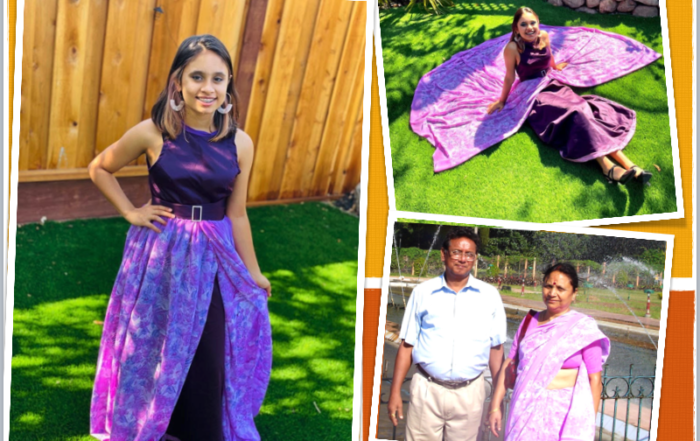Radha-Krishna: The Colors of Divinity

By- Anika Shiroor, 8th Grade During this past summer holiday, our art school was deciding projects for all of us. I was given a watercolor landscape village project by Ms Nidhi and it did not excite me since I had drawn landscape scenes multiple times before. So I asked her if I could do a […]
Happiness is… Having Hot Pot

By- Vivian Gao, Senior 2023 Food has always brought people together, and my family is no exception. Family meals provide an opportunity for family members to come together, strengthen ties and build better relationships. In our busy lives being together with family for food is really important, as old tradition used to be. In my […]
Fashion-Transcending a Fabric Between Generations

By- Saesha Sharda, Sophomore, 2021 My grandmother, Nani, had a beautiful saari: a purple one with floral patterns all over. Nani was amazing at dress-making and knitting. As far as I can remember, I have been wearing her hand-knitted sweaters and hand-me-downs. So, I decided to transform her purple saree into a formal designer dress/piece. […]
COVID Hang Back-2.5 years, One painting

By Aditi Manchanda- 2022 This is the story of my journey with one painting over 2 years. When I first started this piece, I was in 7th grade. Once I found out we were doing a still-life concept, I excitedly drew out what I wanted to paint. A big silver jug on a book, some […]
Changing Our Wiring

By Saesha Sharda, Sophomore, 27 November 2021 Humanity does not have a lack of struggles, and nowadays chaos is dissociating into different parties, groups, and movements. Sometimes, it is important to take a step back and think about the basic things required to clear the chaos, and that is exactly what my artwork focuses on. […]
Importance of Art Education for Young Brains

By- Saanvi Sharma, 8th Grade “Creativity is contagious. Pass it on.” -Albert Einstein. One of the greatest mathematicians in history has thought of creativity and art as so important, that he passed on this quote for generations to ponder. Creativity is usually hidden beneath all other worries and stress that people face, but with the […]
My Tween Brush Strokes-The Golden Gate Bridge

By- Aditi Manchanda, Sophomore 2022 This painting is of the Golden Gate Bridge and is one of my oldest paintings. I made it when I was in 6th grade. It has so many memories associated with it that I thought to document them in my art blog; “Better late than never :)’I don’t remember much […]
Why do I Matter, coz I believe

By- Aditi Manchanda, Grade 8 This is my artwork from the Virtual Reflections Art Competition that was held during the month of October. The theme for this contest was “Why do I Matter”. The first thing that I did was make the head into a light bulb. This is the main portion of the focus […]
Mumma Bear;Shading Techniques

By Saira Siraj, 7th Grade The first artwork (of the two that I will be talking about) that we did is a shading techniques page. Here we have 4 different ways to shade in a drawing, shading, scumbling, stippling, and hatching. I first made a 16by16 grid towards the bottom of the page. Then we […]
Journey of my comic art

By Arjun Anand 8th grade As a kid, I liked to watch superhero movies like The Avengers and Justice League. I liked seeing the superheroes fly around and run faster than the speed of light. These movies started my love for superheroes, which has continued to this day. As I grew up, I started reading […]







